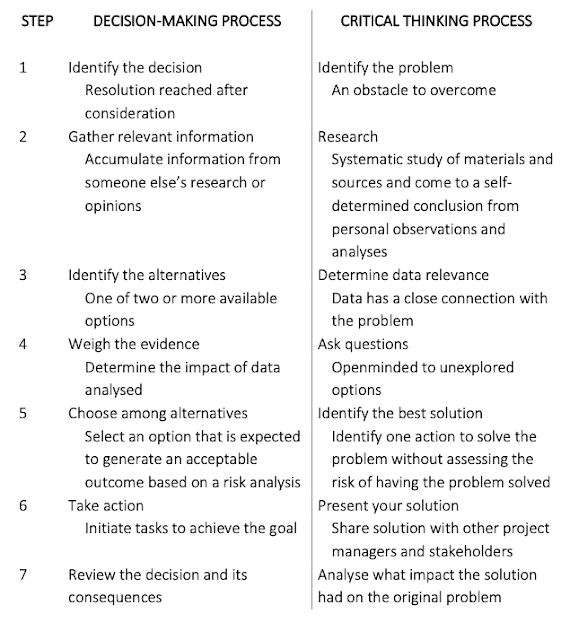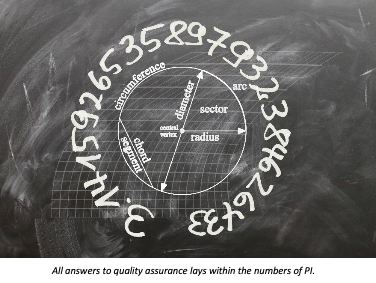Critical Thinking
By OffRoadPilots
Critical thinking is the ability to think clearly and rationally, understanding the
logical connection between opportunities and options. Critical thinking is also
known as the ability to engage in reflective and independent thinking. In essence,
critical thinking requires a person to use your ability to reason. It is about being an
active learner rather than a passive recipient of information. Critical thinkers
rigorously question ideas and assumptions rather than accepting them at face
value. Critical thinkers seek to determine whether conditions, ideas or findings
represent the entire picture and are open to discover other opportunities. Critical
thinkers identify, analyse, and solve problems systematically rather than by
intuition or instinct. Critical thinking is thinking about things in certain ways as to
arrive at the best possible solution in the current circumstances. In other words, it
is a way of thinking about whatever is presently occupying a mind so that a person
comes to the best possible conclusion.
Critical Thinking is a way of
thinking about particular
things at a specific time and
is not the accumulation of
facts and knowledge but is
about the mindset
discovering options in a 3D
environment. A 3D
environment is a mindset
analysing opportunities in
time (speed), space
(location), and compass
(direction). Someone with critical thinking understands links between options, determine the
importance and relevance of options, and recognize, build, and analyse themdifferent avenues available. A person with critical thinking skills identifies inconsistencies and errors in reasoning, approach problems in a consistent and systematic way, and reflect on the justification of their own assumptions, beliefs,
and values.
The skills a person needs for critical thinking are varied and include observation,
analysis, interpretation, reflection, evaluation, inference, explanation, problem
solving, and decision making. Specific skills are to be able to think about a topic or
issue in an objective and critical way, identify the different options there are in
relation to a particular issue, evaluate a point of view to determine how strong or
valid it is, recognize any weaknesses or negative points that there are in the
evidence or argument, notice what implications there might be behind a
statement, and provide structured reasoning and support for options available.
Characteristics of critical thinking are open-mindedness, respecting evidence,
respecting reasoning, being able to consider different perspectives and points of
view and having cognitive flexibility, not being stuck in one position, develop
skepticism, and having clarity and precision.
Decision making skills are
required for critical thinking,
and there is a fine line
between a decision-making
process and a critical thinking
process, and critical thinking
is therefore different from
decision-making. Decision
making is the process of making choices by identifying a decision, gathering information, and assessing alternative resolutions. Using a step-by-step decision- making process can help a person to make more deliberate, thoughtful decisions by organizing relevant information and defining alternatives. This approach increases the chances to choose the most satisfying, or appropriate alternative
possible. Critical thinking is the intellectually disciplined process of actively and
skillfully conceptualizing, applying, analyzing, synthesizing, and evaluating data
generated by, observation, experience, reflection, reasoning, or communication, as
a guide to an action.
There are seven steps to both a decision-making process and a critical thinking
processes.
Without a non-punitive policy, critical thinking is incompatible with aviation safety,
airline and airport operations, and the safety management system (SMS). One
reason that it is incompatible is that a certificate holder is required to appoint an
individual as accountable executive (AE) to be responsible for operations and
accountable on behalf of the certificate holder for meeting the requirements of
the regulations. Interpreting regulations does not allow for independent, or critical
thinking, but requires the accountable executive to follow a pre-established
compliance path. However, a functional SMS must accept resilience and
independent actions, and every person within an SMS organization are authorized
by the non-punitive policy to apply their critical thinking skills and action
accordingly. There is a difference between regulatory compliance and conforming
to regulatory requirements. Regulatory compliance, which is only available in a
static environment, and there is a regulatory compliance gap at the first movement
of an aircraft or airport operation. E.g., an airport receives an airport certificate
prior to accepting their first scheduled flight, and an airline receives their operating
certificate prior to launching their first flight. Regulatory compliance is about
technical, and tasks performed compliance, while conforming to regulatory
requirement is about work processes and how the work is done.An easy trap to fall into for an inexperienced AE is to apply regulatory requirement compliance to work practices. When applying regulatory compliance to operations, 100% of all personnel must comply with standard operating procedures 100% of the times, and to a level of 100% satisfaction. If one item is unsatisfactory, it is impossible to go back in time since there is motion in operations, and the person, pilot, or airside worker, failed. A failed person, causing regulatory non-compliance, cannot continue their operational tasks for the same reason that they are not able
to go back in time and fix their mistake. They are still able to redo their task, but it
is already too late since the non-regulatory compliance already has occurred.
When applying the principle for processes to conform to regulatory requirements,
e.g. performance-based regulations, then it becomes practical and work related to
maintain a healthy operation conforming to regulatory compliance.
Critical thinking is
incompatible with a
regulatory requirement for
airlines and airports to
operate with a process for
setting goals for the
improvement of aviation
safety and for measuring the
attainment of those goals
unless an SMS enterprise
operate with a non-punitive
policy. Determining goals
that improve aviation safety are subjective goals, and goals that fit inside the box.
Critical thinking becomes the outsider an unacceptable within an SMS system,
which is about consensus. The non-punitive policy itself must be without biased to
allow for critical thinking to flow freely.
Critical thinking is incompatible with a regulatory requirement to operate with
procedures for involving employees in the implementation and ongoing
development of the safety management system. At first sight this sounds like a great idea, and helpful to a healthy safety management system. Procedures are one-fit-all and established by management. Pilots or airside workers do not have the authority to establish their own preferred procedure. Procedures are ridged and all workers are required to follow establish procedures when conducting their work-related tasks. Critical thinking becomes an asset to operation when procedures allow for resilience, and independent evaluations when a task departs from the normal path. For critical thinking to be accepted, and SMS enterprise
must operate with, and apply without hesitation, a non-punitive policy.
Critical thinking is
incompatible with a
regulatory requirement to
operate with a system to
monitor the concerns of the
civil aviation industry in
respect of safety and their
perceived effect on the
holder of the certificate.
This regulatory requirement
requires an interpretation of
what the aviation industry
perceive, and open for a
wide range of interpretations. An airline may interpret an airport to be dangerous,
or unsafe since they operate differently than other airports without evidence of
fact. Perception is an exceptional evaluation tool, but it is necessary to know that perception is biased and filled with a ton of assumptions. This regulatory requirement is incompatible with critical thinking, since an airport must adapt to a customer's need to stay in business, which might not always be a path to safety in operations. An example is when the airport operator chose to operate with an
oscillating runway to satisfy one customer’s need to operate without being
interrupted by airport construction.
Critical thinking is an essential part of a healthy SMS, but the AE must accept the
non-punitive policy and that actions taken, whether it is a perfectly performed
checklist, complete procedure compliance, decisions by a committee after long
discussions, or by critical thinking do not always produce the expected outcome.
OffRoadPilots














